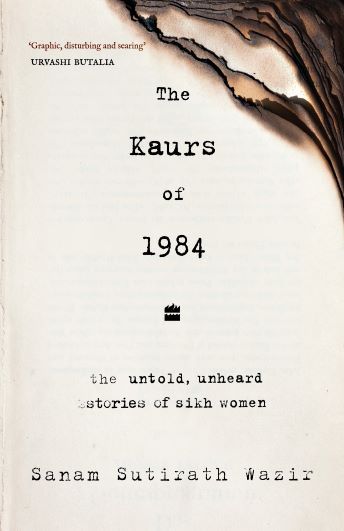Sukriti Tankha
Main chauraasi ki ladki hun (I am a woman who has survived 1984) that’s how a Sikh woman, victim of 1984 anti-Sikh genocide in Delhi, describes herself- in the book. Just this sentence is enough to tell you what atrocities she must have endured. (It also prepares you for what lies ahead in the book).
Today, 40 years later, she is still living that trauma – living it because she saw those men who violated her, were made more powerful by the political party they belonged to; she couldn’t even pursue a legal battle to get her rapists punished, for, no one really ever bothered to know her side of the story.
Considered weak and pushed back, today these very women have emerged stronger; and are telling their life-story in no uncertain words.
I am talking about the new book The Kaurs of 1984 – the untold, unheard stories of Sikh women, published by HarperCollins, which has given voice to all those women – abused and traumatised during the during the Operation Bluestar, Operation Woordrose and anti-Sikh genocide after the then Prime Minister of India Indira Gandhi was assassinated, in 1984.
History has shown us women have always been the first-hand sufferers of any riots, communal fights, even inter and intra-family fights. But they are hardly talked about. No one is interested in hearing their story. Perhaps, they are lesser mortals. And 1984 riots were not different. While many stories have been written on it, there is hardly any which talks about what Sikh women went through. In that sense, The Kaurs, is a good attempt.
Authored by Sanam Sutirath Wazir, the book documents the oral histories of as many as 40 women, who were direct witness to their husbands/ father/ brother burnt alive – some in a very heinous ways. Not unexpectedly, some of these turned into militants themselves, like Nirpreet Kaur, whose story also features in the book. A college student then, and militant later, Kaur now runs an orphanage in Chandigarh. There are more such heartrending stories of – Rajbir Kaur, Harmeet Kaur, Darshan Kaur, Satwant Kaur, Bimal Kaur, Harjeet Kaur, Gurdev Kaur, Rajinder Kaur…
A culmination of data collected over a period of 10 years, this book serves as an encyclopedia on the 1984 pogrom and its aftermath. The author has been quite successful in bringing out the pain and angst of all these women. Each of the chapters in the book Chaurasi ki na insafi, From pens to guns, Militant bride, The daughter of a cop, The widows in Delhi etc is increasingly painful than the other.
In this thoroughly-researched book, Wazir has minced no words while bringing out the horror and the pain of the women who survived the atrocities done to their men and their families, built their life again after suffering huge losses.
And, I must say, the stories literally drain you – emotionally. It won’t be wrong to say that I felt deep distress after reading the book. Perhaps, that is also one of the motives of the author – to let the reader experience the trauma and loss these women felt, and also marvel at their resilience, and hope.
